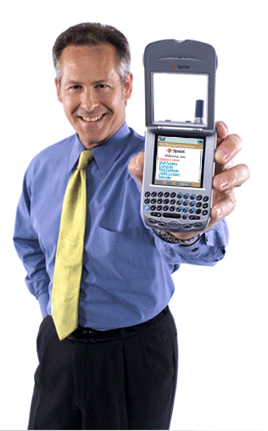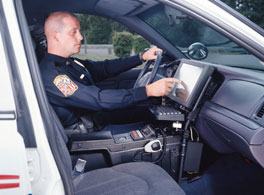|

Maybe we can't.......
tell you everything you need to know about mobile data, but we will try to give you a broad overview of what it is, what it does, how it works, and rough approximations of cost.
There are essential four components making up a typical mobile data system. There are:
The mobile data terminal or MDT
The information transfer network or ITN
The data management software or DMS
The data files to be accessed
We will discuss each component separately to help you get a general overview of a mobile data system designed to fit your specific needs. Let's start with the MDT.
MDT's come in essentially four different types:

Personal data assistants using Palm or Pocket PC operating systems. Such devices are normally dependent upon a public network such as Sprint or SouthernLINC. Speed and available coverage area varies with each carrier. Typical cost is under $700. This can be an excellent choice for use by personnel on foot (bike patrols, stake outs, etc.). Call us at 1-800-489-2611 for additional information.
Tablet, pen based, or laptop computers can be used as MDTs if they have a Type II PCMCIA interface to allow insertion of a device known as an AirCard. Ordinary laptop computers can meet the operational requirements of an MDT but they are generally lacking in two major areas. They are not designed for installation in a vehicle. They can be mounted in a vehicle but reliability is not on a par with a PC designed for mobile use. Cost ranges from under $1,000 upwards to $3,000 depending on model and features selected.
The so called hard body PC's are ruggedized versions of what appears to be a standard tablet or laptop PC. In simple terms, they have extra padding and extra protection. Generally speaking they suffer many of the same problems as an ordinary laptop (i.e. they are hard to see in sunlight, and they rarely have touch screen capability). These units tend to cost three to four times more than a standard PC with comparable features (i.e. $3,000 to $5,000).
True MDT's were designed from the beginning as a mobile data terminal. These devices tend to be easier to install, more stable in a mobile environment, and typically feature touch screen high visibility displays. The units we offer have a PCMCIA slot on the top of the unit that allows connection of any compatible Aircard from the carrier of your choice. The placement of the access slot on the top gives this unit significantly better coverage over units that have the access slot on the side. Typical costs will be in the $4,000 to $5,000 range making the true MDT a little more expensive initially but significantly better suited for a mobile environment.
The information transfer network (ITN) is the wireless conduit between the MDT and a remote terminal where data may be stored or another user with a comparable MDT. There are several common ways to convey this information.

The Sprint 3G Public Network is reportedly the fastest and most efficient network currently in operation with operating speeds of up to 144K (almost three times faster than a dial up modem and nearly equal to consumer grade cable or DSL modems).
GSM/GPRS (General Packet Radio Service) service is a "next generation" technology available in many major U.S. This service normally operates in the 40kbps to 60kbps range. What you see on your dial-up screen is the same as what you see on your Express Network Screen. The Wireless Modems use a SIM card in place of the traditional IP Address system.
CDPD (Cellular Digital Packet Data) service is a "first generation" technology available in many major U.S. Cities from Verizon Wireless and Cingular Wireless (Ohio/Michigan only). The infrastructure consists of a wireless modem in a laptop or PDA which uses a static IP address to transmit and receive digital data packets at speeds up to 19.2kbps
The SouthernLINC Public Network is purported to have the most extensive coverage in rural areas with speeds not reported on the company web site although Nextel, using comparable technology, claims download speeds of up to 56K. No reference has been found referring to upload speeds or the speed without compression.
DataRadio offers a modem for UHF, 800, or 900 MHz that provides speeds of up to 22K on currently assignable FCC designated 12.5 kHz channels. With an installed price tag of approximately $3,500, and a huge infrastructure investment, this system is generally restricted to use only by larger agencies. The well-known MOBILPAC II is available for VHF, 220, UHF and 800 MHz with narrow band data speeds of 9600 baud.
Falcon Wireless offers a radio modem capable of operating on either VHF or UHF frequencies with speeds of up to 19.2K on 25 kHz or 9.6K on 12.5 kHz channels. Installed cost is less than $500 per vehicle.
Wi-Fi or 802.11 has long been used for cordless phones, fixed links, and wireless in-building networks. Some public safety users are beginning to use this ultra high speed (11 mbps) for wide area mobile applications. Cost will vary depending on the number of sites constructed. Falcon Wireless can assist in planning a Wi-Fi system.

In order to manage the exchange of data, it is necessary to utilize some type of software to synchronize the MDT with the information data base. Users who already have CAD (Computer Aided Dispatch) systems from software companies such as Intergraph, Vision, etc. can generally purchase a mobile data module to perform this function.
If you don't have a software vendor, Falcon Wireless, working with Riverchase Technology can assist you in setting up the required software. Smaller users can acquire a low cost software alternative through the use of Voyager Query, available through Falcon Wireless.
The final element of a mobile data system is the data to be transferred. Data can reside at any number of places on a server, on the Internet, or even on another terminal. If the files are on your own server, the exchange can easily be handled through the DMS software.
If the data is somewhere else, such as NCIC, the owner of that data must qualify you for access and they will make the determination as to what the cost and conditions of access will be.
If the data is on the Internet, you have to decide if you want your MDT's to have full or restricted Internet access. A qualified systems integrator such as Falcon Wireless can assist you in all areas of your system planning.
Do we have some personal preferences? You bet we do! In rural areas, a 9600 baud radio modem is perfectly acceptable for data exchange. It is not color photos or full motion video, but more than adequate for basic record searches and text messaging between MDT's.

As far as MDT's go, we have only one recommendation DataLux. Nothing else even comes close! The DataLux Tracer can be installed easily and quickly in standard patrol vehicles and it is as solid as a rock! Nothing else even comes close!
In some cases, we have assisted smaller communities using hybrid technology. Additional information on one of our system users can be found in the mobile data section at www.alaprotect.com.
If you are in the Sprint network coverage area, we believe this is an ideal balance between speed and cost. To find out more, email us at sales@falconwireless.net. Tell us your name, title, organization, address, and phone number. You will be amazed at what we can do for your community for so little money with flexible payment plans than can meet your requirements. Send us that email today. You'll be glad you did!
|

